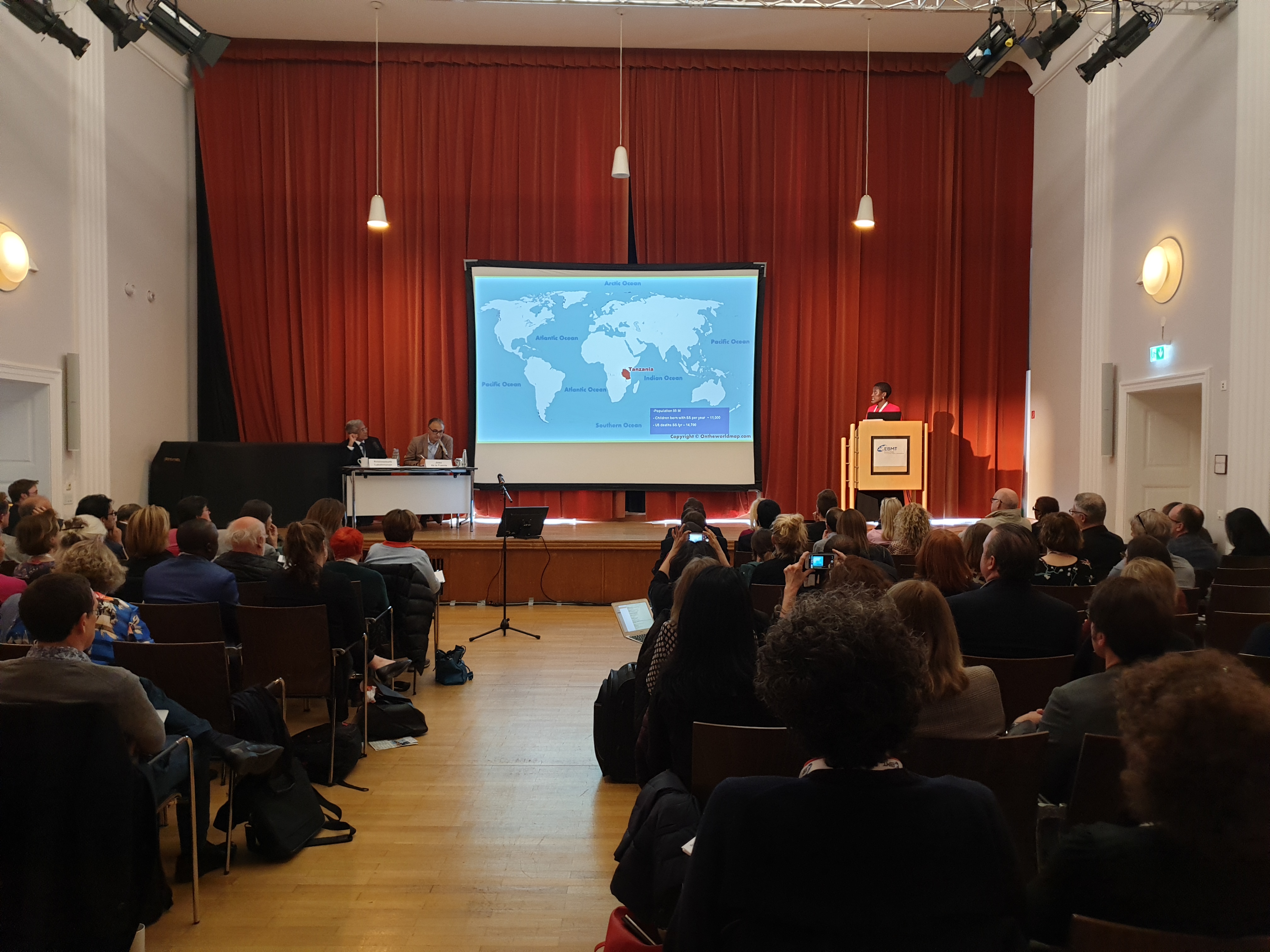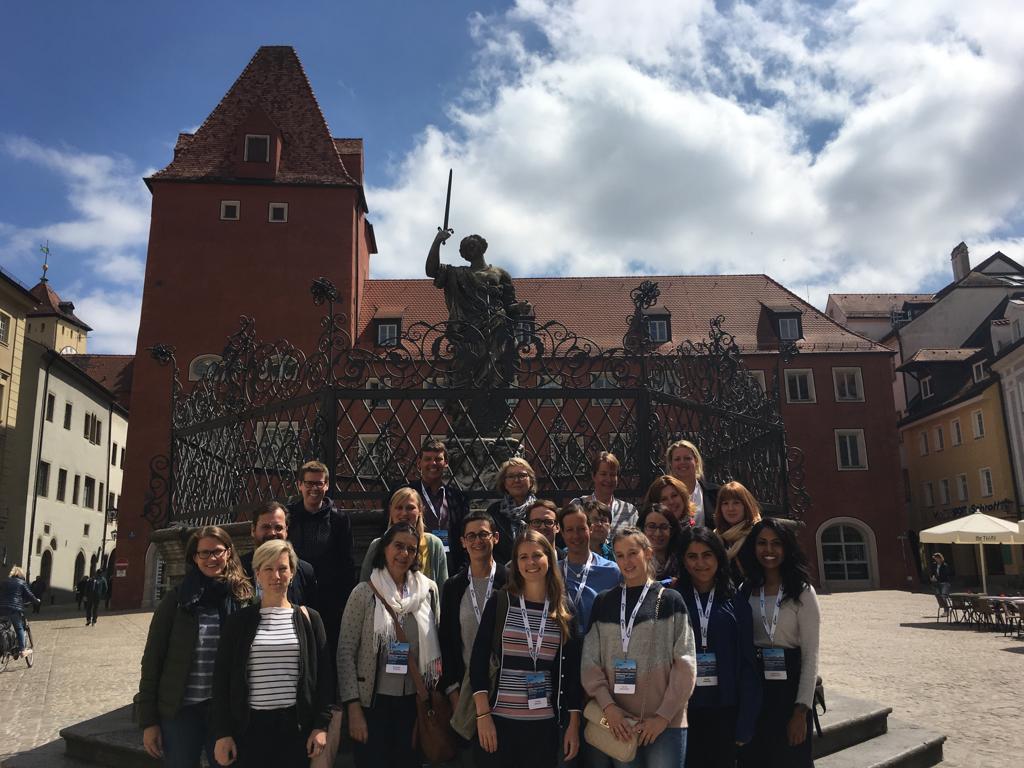
Paediatric Diseases Working Party Meeting: Sickle Cell Disease, what are the curative options?
16-17 May 2019 in Regensburg, Germany
Report by Katharina Kleinschmidt, Secretary of the Paediatric Diseases Working Party (PDWP)
The 5th international Sickle Cell Meeting “SCD: what are the curative options?” took place on May 16th and 17th in the city of Regensburg, Germany. This year it was adopted as an official EBMT Educational meeting of the PDWP. The faculty included around 20 experts and recognized leaders in their respective fields and presented a comprehensive state of the art overview of the current treatment options for SCD. The meeting was attended by 123 participants from 16 different nationalities, including the American, African and Asian continents.
Thursday, May 16th
Miguel Abboud (Lebanon) opened the meeting with an update on conventional therapy for SCD, including “basic” approaches like hydroxyurea, transfusion strategies and ACE-inhibitors for SCD nephropathy, as well as new approaches like glutamine, which has been shown to increase the NAD redox potential, and to decrease endothelial adhesion. Francoise Bernaudin (France) addressed the issue of the role of HSCT in the management of cerebral vasculopathy in children with SCD. Julie Makani from Tanzania gave an impressive insight in the treatment approaches and the respective difficulties in developing countries; an aspect followed by Mahmoud Aljurf (Saudi Arabia) who discussed HSCT for SCD patients in the Eastern Mediterranean; considering that the only curative treatment option is still less available in many countries with a high prevalence. Subsequently, Lawrence Faulkner (Italy) presented the Cure2Children concept “How to setup a successful transplant program for hemoglobinopathies in developing countries”, with the impressive example of HSCT for thalassemia in India, where excellent outcomes are achieved with very limited resources.
In the second session of the day, three extremely relevant questions have been addressed by three uncontested experts of their field:
- Krishnamurti Lakshmanan (USA): “Should young children without severe disease with a matched sibling be offered BMT”?
- Josu de la Fuente (UK): “Should children/young adults with nonsevere disease be offered an alternative donor HSCT?”
- Pietro Sodani (Germany): “Is a MUD equivalent to a MSD for transplantation of SCD patients?”
These provocative presentations evolved spontaneously into a very interactive and animated discussion between the audience and the speakers, addressing all relevant aspects related to these important questions. The majority of the participants as well as the speakers, based on the excellent outcomes, agreed that all patients with SCD and an HLA identical MSD should be at least offered HSCT before developing organ dysfunction, an option which is available however only for less than 20% of patients. Unfortunately, the success of MSD-HSCT in SCD could not be translated to MUD-HSCT. In comparison of current donor choices as best option for 80% of the patients, the haploidentical setting is increasingly considered the most promising alternative. This issue was addressed in detail on the second day of the meeting.
Friday, May 17th
Session III focused on HSCT of SCD. Jean-Hugues Dalle (France) focused on the general difficulties of collaboration and translational approaches by hematologists/pediatricians, who are the first health care providers for SCD patients and the transplant physicians. This issue was extensively discussed, with both groups having different competences and treatment approaches. Eliane Gluckman (France) presented a comprehensive overview on alternative donor HSCT for SCD in Europe, an issue which was further discussed in a detailed manner for the post-transplant cyclophosphamide approach by Adetola Kassim (USA). Selim Corbacioglu (Germany), the working party chair, presented in contrast the data from the pilot study on aß/CD3 T cell depleted haploidentical HSCT, where 13 MSD have been compared to 25 T-haplo patients. Based on the comparable and excellent outcomes of OS, DFS and incidence of a/c GvHD, a prospective, multicenter, two-armed stratified phase 2 trial is currently in preparation.
As ATG by now represents a consolidated component of numerous transplant regimens, Lisa Oostenbrink (Netherlands) discussed the impact of pharmacokinetics with measurement of active ATG has shown significant differences between the different products currently in use, so that taking into account these specifications are increasingly pivotal to optimize outcome in relation to diseases and transplant settings.
The question raised by Marta Palomo (“Is sickle cell disease related neurotoxicity a systemic endotheliopathy?”) lead directly to the Lunch-Symposium, supported by Jazz Pharmaceuticals, dedicated specifically to the management of endothelial post-transplant complications in SCD (speakers: Selim Corbacioglu (pathophysiology), Krzysztof Kalwak (diagnosis), Jean-Hugues Dalle (management)).
The last session concluded the meeting by discussing all aspects of gene editing for SCD. John Tisdale (USA) highlighted the lentiviral gene therapy approach, where even modest expression rates of gene-edited cells showed to be clinically effecacious (reduced frequency of vaso-occlusive crises and acute chest syndromes, as well as decreased hemolysis following LentiGlobin gene therapy). David Williams (USA) described in an exciting presentation the possibility of transgenic knock-down of BCL11A, a repressor of g-globin to induce fetal globin expression via a lentiviral vector system. Fabio Ciceri (Italy) furthermore presented the Milan experience of HSC lentiviral gene therapy for adult and pediatric patients with transfusion-dependent ß-thalassemia. In conclusion of this rich meeting, Selim Corbacioglu briefly summarized the CRISPR/cas9 technique being an efficient tool for editing of targeted genes. Two phase 1/2 studies are currently evaluating the safety and efficacy of CRISPR/Cas9 modified CD34+ hematopoietic stem and progenitor cells in subjects with either transfusion-dependent ß-thalassemia or with severe SCD.
In conclusion, the 5th International Sickle Cell Meeting can be considered a huge success, evidenced by the continuously increasingly attendance, and by the extraordinarily vivacious and constructive discussions with the audience, emphasizing the substantial relevance and the increasing interest of the scientific community for this devasting disease.

Report by Daphna Hutt, Chair of the Nurses Group Paediatric Committee
Twenty five nurses attended the meeting from various countries as Austria, Belgium, Finland, Germany, Italy, The Netherlands, Monaco, United Kingdom, Spain and Israel.
The Scientific nurses program was organised by the Nurses Group Paediatric Committee along with cooperation of the local nurses Gerald Collier and Christoph Bauer. Nurses had parallel sessions to the physicians along with one joint symposium on managing endothelial post-transplant complications in Sickle cell disease (SCD). The nurses program was varied with topics covering a general overview on SCD, supportive care on SCD with chelation therapy, transcranial Doppler scan and the special psychological burden in SCD patients. Transplant related issues as haplo transplants in SCD and skin problems. During the pain management session, pain in pediatric patients as well as pain in adults SCD patients was discussed. We were fortunate to hear a patient talk on her experience. Round table discussions were held on two topics that the majority of the nurses chose at the start of the meeting:
1. Multi-cultural care and cultural barriers - The group discussed language barriers and what kind of translators are available in the different centers i.e. employees who speak various languages; translation services over the phone; use of students etc. Various cultural issues were discussed as trust in God; various religious beliefs and behaviors; different ways of living and background.
2. Supportive care - The majority of the time was dedicated to an interesting and fruitful discussion around pain. Pain in SCD patients is real and we have to take it seriously. We need to listen to the patients and how they describe their pain. It is very important to have the courage to start with stronger medications like morphine early enough, because the pain can be very painful. The nonpharmacological strategies in relieving pain are also important to remember, as stressful situations can trigger the pain like other psycho-social and environmental states. Psycho-social issues- due to time limit the group only discussed the issue of how many centres allowed parents to stay overnight with their child in hospital.
A tour to the BMT unit at the Universitätsklinikum Regensburg closed the nurses meeting.
The Nurses Group grant to participate to the meeting was given to Shari Noraiee from the UK. She explains: “Ever since I started my nursing career, I have looked to increase my knowledge on sickle cell disease. So when the opportunity to travel to Regensburg presented itself, I jumped at the chance to learn more about the diseases. The event was well structured which gave me the opportunity to listen to industry experts on the subject. Hearing there perspective on the subject gave me the motivation to help create a change where I worked. On the visit to Regensburg hospital my eyes were open to the how this can all be achieved and applied in a work place. Since being back I’ve started to look for courses to help build on what I learnt that the event. Thank you for the opportunity and look forward to another event.”
